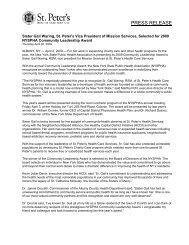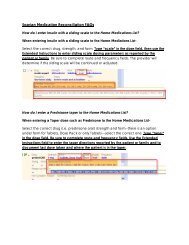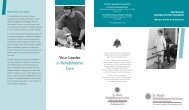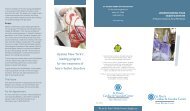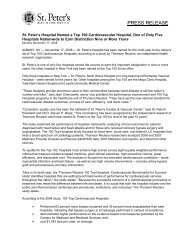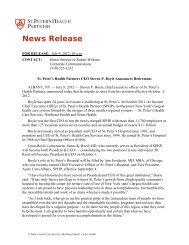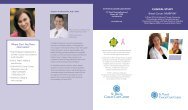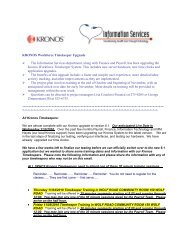Caring for Yourself and Your Baby - St. Peter's Hospital
Caring for Yourself and Your Baby - St. Peter's Hospital
Caring for Yourself and Your Baby - St. Peter's Hospital
Create successful ePaper yourself
Turn your PDF publications into a flip-book with our unique Google optimized e-Paper software.
The science of medicine.<br />
The compassion to heal.<br />
CARING FOR YOURSELF<br />
AND YOUR BABY
The addition of a new baby to your home is a<br />
special, happy time <strong>for</strong> you, your partner <strong>and</strong> your<br />
family. Due to the many changes taking place, it can<br />
be a hectic <strong>and</strong> challenging time as well. Changes in your<br />
body, your relationships <strong>and</strong> your daily routines can<br />
sometimes make you feel overwhelmed. Underst<strong>and</strong>ing<br />
as much as you can about these changes will help<br />
make the initial days of motherhood more relaxing <strong>and</strong><br />
enjoyable.<br />
We hope the in<strong>for</strong>mation provided here will help address<br />
many of your questions <strong>and</strong> concerns. Remember, your<br />
nurse at <strong>St</strong>. Peter’s <strong>Hospital</strong> will gladly answer any<br />
questions you have about your care or the care of your<br />
new baby. Feel free to call anytime. There are special<br />
concerns that you may want to discuss with your<br />
physician. He or she can offer excellent advice regarding:<br />
• Family planning<br />
• Tub bathing<br />
• Driving a car<br />
• Taking medications<br />
• Exercising <strong>and</strong> physical activity<br />
• Smoking, drinking of alcoholic or caffeinated<br />
beverages, or taking drugs while breast-feeding
Recovering After Delivery<br />
WHAT TO WATCH FOR<br />
Notify your physician if you experience<br />
any of the following symptoms:<br />
• Temperature greater than 100.4°<br />
or chills<br />
• Breast or leg pain or redness<br />
• Increasing pain<br />
• Incision or episiotomy redness,<br />
swelling or drainage<br />
• Thickened or foul-smelling vaginal<br />
bleeding<br />
• Vaginal bleeding that is heavier<br />
then a normal period, or passing<br />
excessive blood clots<br />
• Any issues that concern you<br />
ACTIVITY<br />
Rest is one of the most important, yet<br />
often one of the most difficult things<br />
<strong>for</strong> you to do when you have a new<br />
infant. All of the changes in your life<br />
will be more manageable if you are<br />
not over-tired. During the first week<br />
home after a vaginal delivery, try to<br />
care <strong>for</strong> just yourself <strong>and</strong> your new<br />
baby. If you’ve had a Cesarean birth,<br />
you will need to take it easy <strong>for</strong> two<br />
weeks. It is a good idea to rest when<br />
your baby is asleep, even if it means<br />
not doing household tasks. Let some<br />
of the housework go, or enlist some<br />
help from relatives <strong>and</strong> friends. You<br />
<strong>and</strong> your partner may need to reassign<br />
some household responsibilities to<br />
give you both enough relaxation time<br />
to enjoy yourselves <strong>and</strong> your new<br />
baby.<br />
Speak to your physician about a<br />
program of exercise that will help<br />
restore your muscle tone <strong>and</strong> help<br />
you lose a few pounds if you feel you<br />
should. There are special exercises<br />
<strong>for</strong> this purpose. <strong>Your</strong> physician is the<br />
best person to identify which exercise<br />
is best <strong>for</strong> you <strong>and</strong> when to begin to<br />
insure safety.<br />
CARE AND COMFORT OF<br />
YOUR STITCHES<br />
(EPISIOTOMY) AFTER<br />
VAGINAL DELIVERY<br />
Initially in the hospital, after the birth<br />
of your baby, your nurse will assist you<br />
in choosing a combination of com<strong>for</strong>t<br />
measures. Com<strong>for</strong>t measures include:<br />
• Use your peri bottle to spray<br />
lukewarm water across your<br />
perineum. Always spray from front<br />
to back.<br />
• Tighten <strong>and</strong> relax your perineum<br />
<strong>and</strong> buttock muscles by per<strong>for</strong>ming<br />
Kegel exercises.<br />
• Use your sitz bath four to five<br />
times during the day to soothe <strong>and</strong><br />
promote healing.<br />
• Use any topical medications given<br />
to you by your nurse or physician.<br />
• Take pain medications as<br />
prescribed by your physician.<br />
At home, continue the practice of<br />
using your peri bottle, Kegel exercises,<br />
sitz bath <strong>and</strong> topical medication. Do<br />
not be concerned if you notice clear<br />
1
Recovering After Delivery<br />
pieces of your stitches, resembling<br />
plastic thread, on your sanitary pad.<br />
This is normal <strong>and</strong> occurs as your<br />
episiotomy heals. <strong>Your</strong> stitches will<br />
heal in about seven to ten days.<br />
Remember not to douche or use<br />
tampons until you discuss it with your<br />
physician at your six-week check-up.<br />
CARE OF ABDOMINAL<br />
INCISION (CESAREAN BIRTH)<br />
If you have a Cesarean birth, it is<br />
important to keep your incision clean<br />
<strong>and</strong> dry. While in the shower, let the<br />
water flow over the incision <strong>and</strong><br />
gently pat it dry. If you have steri<br />
strips over your incision, they will<br />
loosen <strong>and</strong> fall off on their own. If<br />
you have stitches or staples, your<br />
physician will determine when they<br />
will be removed. If your stitches or<br />
staples have not been removed<br />
be<strong>for</strong>e you are discharged from the<br />
hospital, call your physician <strong>for</strong> a<br />
follow-up appointment within one<br />
week. Remember to report to your<br />
physician any redness, drainage or<br />
excessive warmth at the incision site.<br />
AFTERBIRTH PAINS<br />
After your baby is born, your uterus<br />
begins contracting as it returns to its<br />
pre-pregnant state <strong>and</strong> size. This<br />
contracting causes some discom<strong>for</strong>t<br />
<strong>and</strong> is usually most noticeable the first<br />
few days after delivery.<br />
VAGINAL BLEEDING<br />
Although the length of time varies<br />
with each individual, vaginal bleeding<br />
after delivery usually continues <strong>for</strong><br />
two to four weeks. The bleeding will<br />
be bright red with some clots at first,<br />
but then will become pink or brown<br />
<strong>and</strong> decrease in amount. Bleeding<br />
should never be heavier than the<br />
heaviest day of your normal period.<br />
If bleeding is heavier than a menstrual<br />
period, cut back on your level of<br />
activity. Call your physician if heavy<br />
bleeding continues. Eventually, the<br />
bleeding will change to a yellowwhite<br />
discharge be<strong>for</strong>e it stops.<br />
If you are not breast-feeding, your<br />
period will probably return in six<br />
to eight weeks after delivery. If you<br />
are breast-feeding, your period may<br />
not return until you stop nursing.<br />
However, it is important to know that<br />
ovulation can occur <strong>and</strong> you may<br />
become pregnant even if you have<br />
not resumed your period. If you are<br />
interested in methods of family planning,<br />
you may wish to consult your<br />
physician. A program of instruction <strong>for</strong><br />
Natural Family Planning is available<br />
through <strong>St</strong>. Peter’s <strong>Hospital</strong>.<br />
POSTPARTUM BLUES<br />
After your baby’s birth, in the hospital<br />
<strong>and</strong>/or at home, you may feel blue or<br />
depressed. You may even experience<br />
periods of unexplained crying. The<br />
“baby blues” are a normal response<br />
2
Recovering After Delivery<br />
to the hormonal changes in your<br />
body <strong>and</strong> the emotional changes<br />
occurring in your life. It is important<br />
to get plenty of rest, because lack of<br />
rest <strong>and</strong> sleep can contribute to the<br />
blues. The blues may last several<br />
hours or several days <strong>and</strong> usually<br />
disappear within a week. If you<br />
become concerned or feel especially<br />
anxious or depressed, please call your<br />
physician.<br />
RESUMING SEXUAL<br />
RELATIONS<br />
You should speak to your physician<br />
about when you will be able to<br />
resume sexual intercourse, <strong>and</strong><br />
about your family planning concerns.<br />
Generally, you may resume having<br />
intercourse once initial healing takes<br />
place <strong>and</strong> you feel com<strong>for</strong>table <strong>and</strong><br />
ready. You <strong>and</strong> your partner should<br />
talk about this be<strong>for</strong>eh<strong>and</strong> to avoid<br />
misunderst<strong>and</strong>ings <strong>and</strong> frustrations.<br />
DIET<br />
<strong>Your</strong> diet is as important after delivery<br />
as it is during pregnancy because it<br />
helps the healing process <strong>and</strong> gives<br />
you energy. Continue to eat a wellbalanced<br />
diet choosing foods from the<br />
four basic food groups:<br />
• Fruits <strong>and</strong> Vegetables<br />
• Breads <strong>and</strong> Cereals<br />
• Milk <strong>and</strong> Dairy Products<br />
• Meat, Fish, Poultry, <strong>and</strong> Eggs<br />
WHILE BREAST-FEEDING:<br />
• Consume an extra 500 to 600<br />
calories each day.<br />
• Increase your protein, especially<br />
dairy products which also contain<br />
calcium. If you cannot tolerate<br />
milk products, other sources of<br />
calcium can be suggested by your<br />
physician.<br />
• Drink plenty of fluids. We<br />
suggest that you drink 8 to 12<br />
glasses of fluids each day.<br />
• Avoid excessive amounts of spicy<br />
<strong>and</strong> greasy foods.<br />
If you are breast-feeding, remember<br />
to eat a well-balanced diet, choosing<br />
from the four basic food groups.<br />
3
Feeding <strong>Your</strong> <strong>Baby</strong><br />
BREAST-FEEDING<br />
Breast-feeding your baby can be one<br />
of the most satisfying <strong>and</strong> rewarding<br />
experiences in a mother’s life. It can<br />
also cause some feelings of frustration<br />
<strong>and</strong> anxiety. You may experience<br />
some nipple soreness at first, <strong>and</strong> it<br />
will probably take a few weeks be<strong>for</strong>e<br />
your milk supply <strong>and</strong> your baby’s<br />
dem<strong>and</strong> complement each other. The<br />
most important thing to remember is<br />
to relax. Breast-feeding is like any skill<br />
– the more you do it, the easier it<br />
gets! Soon both you <strong>and</strong> your baby<br />
will become confident <strong>and</strong> at ease.<br />
Wear a supportive bra. When<br />
bathing, wash breasts with plain,<br />
warm water. Soap can cause nipples<br />
to become dry <strong>and</strong> add to soreness.<br />
Air-dry nipples after each breast-feeding.<br />
If your breasts become uncom<strong>for</strong>tably<br />
firm or sore, take a warm<br />
shower or apply wet warm packs<br />
around your breasts be<strong>for</strong>e nursing.<br />
Many new moms find breast massage<br />
com<strong>for</strong>ting as well. It is important to<br />
remember that proper positioning of<br />
your baby at the breast is helpful in<br />
preventing sore nipples. You might try<br />
to use various positions <strong>for</strong> different<br />
feedings.<br />
It is normal to ask, “Is my baby getting<br />
enough milk?” Babies should be<br />
nursed at least eight times in a 24<br />
hour day! Here are some signs that<br />
your baby is receiving enough milk:<br />
• 6 to 8 wet diapers/day<br />
1 to 2 stools/day<br />
What a baby takes in, a baby<br />
puts out.<br />
• Nursing every 2 to 3 hours<br />
during the day, every 4 to 5 hours<br />
at night.<br />
If you have questions or concerns,<br />
contact community resources<br />
(i.e. La Leche League, a lactation<br />
consultant, or your pediatrician). A list<br />
of resources can be found in the back<br />
of this booklet.<br />
BREAST FULLNESS/<br />
ENGORGEMENT<br />
If you choose to bottle-feed your<br />
baby, you may experience breast fullness<br />
or engorgement within two to<br />
four days after delivery. This is normal<br />
<strong>and</strong> will usually subside in a few days.<br />
Wear a support bra 24 hours a day<br />
while your breasts are engorged.<br />
Take the bra off only to shower.<br />
When you shower, face away from<br />
warm or hot water. Warm or hot<br />
water on your breasts will stimulate<br />
engorgement. Do not express any<br />
milk from your breasts. If your breasts<br />
become very hard <strong>and</strong> tender, apply<br />
ice packs to your breasts <strong>for</strong> 10 to 15<br />
minutes, four times a day.<br />
4
Feeding <strong>Your</strong> <strong>Baby</strong><br />
BOTTLE-FEEDING AND<br />
BURPING<br />
Formula may be fed at room<br />
temperature. If cold from the refrigerator,<br />
<strong>for</strong>mula is best warmed by<br />
placing the bottle of <strong>for</strong>mula in a pan<br />
of hot water. Do not use a microwave<br />
oven <strong>for</strong> heating <strong>for</strong>mula. It<br />
can result in burns to you or your<br />
baby. Microwaving can cause the<br />
<strong>for</strong>mula to overheat or <strong>for</strong>m “hot<br />
spots.”<br />
At feeding time, find a com<strong>for</strong>table<br />
spot <strong>for</strong> you <strong>and</strong> your baby. Using a<br />
rocking chair is popular. Hold your<br />
infant in your lap with his/her head<br />
resting in the curve of your arm. Hold<br />
the bottle at an angle so that the neck<br />
of the bottle is kept full of milk.<br />
All babies swallow air <strong>and</strong> need to be<br />
burped. After each feeding, <strong>and</strong><br />
sometimes during the feeding, you<br />
will want to burp your baby. There<br />
are three ways to do this:<br />
• Over the shoulder – hold the<br />
baby in an upright position next<br />
to your body, supporting his/her<br />
head on your shoulder. Gently<br />
tap <strong>and</strong> smooth baby’s back with<br />
an upward motion.<br />
• On your lap – lay baby across<br />
your lap on his/her abdomen.<br />
Gently tap <strong>and</strong> smooth baby’s<br />
back.<br />
• Sitting on your lap – sit baby on<br />
your lap leaning his/her head<br />
slightly <strong>for</strong>ward, supporting head<br />
<strong>and</strong> chest with one h<strong>and</strong> <strong>and</strong><br />
gently tapping <strong>and</strong> smoothing<br />
baby’s back with the other.<br />
Babies do not always burp after a<br />
feeding, so do not insist if your baby<br />
does not burp right away.<br />
FORMULA PREPARATION<br />
There are several methods <strong>for</strong> cleaning<br />
bottles. Discuss these methods<br />
with your physician. Whatever<br />
method you use, first thoroughly<br />
wash <strong>and</strong> rinse all equipment. After<br />
cleaning equipment, prepare the<br />
infant <strong>for</strong>mula according to instructions<br />
on the <strong>for</strong>mula container <strong>and</strong><br />
pour it into the clean bottles. Fill<br />
bottles to desired amount <strong>and</strong> place<br />
nipples on the bottles, either inverted<br />
with disc seals or upright with nipple<br />
covers. Remember that microwave<br />
ovens not only can cause burns, but<br />
are ineffective <strong>for</strong> cleaning equipment.<br />
5
Keeping <strong>Your</strong> <strong>Baby</strong> Safe<br />
Calling the Doctor<br />
Safety measures are an important<br />
aspect of your baby’s care.<br />
Newborns are known to do the<br />
unexpected! Call your pediatrician if<br />
any of the following occur with your<br />
baby:<br />
• Breathing difficulty<br />
• Fever of 101° or above<br />
• Infant not feeding well or<br />
vomiting<br />
• Change in voiding <strong>and</strong><br />
stooling patterns<br />
• Persistent crying<br />
• “Not acting right”<br />
• Rashes<br />
Remember, pediatricians expect<br />
frequent calls from new mothers<br />
while they get to know their new<br />
babies. Keep in touch with your<br />
pediatrician as needed <strong>and</strong> always<br />
feel free to contact your nurse at<br />
<strong>St</strong>. Peter’s if you are concerned about<br />
anything in particular.<br />
NURSERY SAFETY<br />
Remove all pillows from your infant’s<br />
crib; secure bumpers to siderails.<br />
Keep powders, lotions, pins, etc., out<br />
of infant’s reach.<br />
Never leave infant unattended on<br />
dressing table or other raised surface.<br />
Use age-appropriate car seat as<br />
m<strong>and</strong>ated by New York state law.<br />
LYING POSITIONS<br />
When placing your baby down <strong>for</strong><br />
sleep, the American Academy of<br />
Pediatrics recommends that the infant<br />
be placed on his or her back. If you<br />
are NOT putting the baby down <strong>for</strong><br />
sleep, it is safe to lay the baby on his<br />
or her belly to foster neck-lifting exercise.<br />
You may also use the side-lying<br />
position <strong>for</strong> an alert, awake infant. It is<br />
important to alternate positions <strong>for</strong><br />
your baby.<br />
PREVENTING SUDDEN<br />
INFANT DEATH SYNDROME<br />
(SIDS)<br />
• No pillows or toys in the crib<br />
• Use a firm crib mattress<br />
• Position on back <strong>for</strong> sleep<br />
• Maintain a room temperature that<br />
is com<strong>for</strong>table to you (babies<br />
should be warm, but not too<br />
warm)<br />
• Create a smoke-free zone around<br />
your baby<br />
SMOKING<br />
Second-h<strong>and</strong> smoke is harmful <strong>for</strong><br />
your baby, leading to a number of<br />
breathing problems, as well as depriving<br />
your infant of necessary oxygen<br />
<strong>for</strong> growth <strong>and</strong> development. Please<br />
do not expose your baby to this<br />
environmental hazard. Do not allow<br />
smoking in your car or home.<br />
6
<strong>Caring</strong> For <strong>Your</strong> <strong>Baby</strong><br />
CRYING<br />
Babies cry <strong>for</strong> many reasons. They<br />
might be hungry, uncom<strong>for</strong>table (wet,<br />
soiled, too hot, too cold), not feeling<br />
well, or just unable to settle down. It<br />
may take a while be<strong>for</strong>e you can recognize<br />
the difference between cries.<br />
Babies learn trust from having their<br />
cries responded to either by voice, by<br />
touch or by holding. You must investigate<br />
the baby’s need. Despite what<br />
people say, you will not spoil a newborn<br />
infant by holding him/her when<br />
he/she cries.<br />
DIAPERING<br />
You may choose either disposable<br />
diapers or cloth diapers that are<br />
laundered <strong>and</strong> reused. Powders <strong>and</strong><br />
ointments are not necessary. Discuss<br />
rashes with your baby’s pediatrician.<br />
Regardless of your choice of diaper,<br />
the most important way to protect<br />
your baby from soreness <strong>and</strong> rash is<br />
by changing him/her frequently.<br />
When changing, remove the soiled<br />
diaper <strong>and</strong> set it out of the reach of<br />
the baby. Clean the baby’s genitals<br />
<strong>and</strong> buttocks gently <strong>and</strong> thoroughly.<br />
Always wipe front to back, from the<br />
genitals toward the anus. It is normal<br />
<strong>for</strong> your baby girl to have a small<br />
amount of creamy or lightly bloodtinged<br />
vaginal discharge due to left<br />
over hormones from the mother. It is<br />
not necessary to vigorously cleanse<br />
the area between the labia.<br />
When your baby is clean, put on a<br />
clean diaper. Keep the diaper folded<br />
below the umbilical cord if possible. If<br />
you are using cloth diapers, be careful<br />
not to stick yourself or your baby<br />
with pins. If pins become dull, you<br />
might find it helpful to stick them in a<br />
bar of soap, then use them.<br />
CORD CARE<br />
Keep the area clean <strong>and</strong> dry to promote<br />
healing. You may sponge bathe<br />
your baby until the cord falls off. This<br />
will take place in about two to three<br />
weeks.<br />
CIRCUMCISION CARE<br />
Clean the circumcised area each day<br />
by gently drawing back <strong>for</strong>eskin <strong>and</strong><br />
cleaning the tip of the penis with soap<br />
<strong>and</strong> water. Immediately after circumcision,<br />
<strong>and</strong> <strong>for</strong> about two to three<br />
days, you may apply petroleum jelly<br />
over the penis at each diaper change.<br />
UNCIRCUMCISED<br />
BABY CARE<br />
Do not <strong>for</strong>ce <strong>for</strong>eskin back <strong>for</strong> cleaning.<br />
Gently wash the penis with soap<br />
<strong>and</strong> water, moving back <strong>for</strong>eskin<br />
without using pressure.<br />
7
<strong>Caring</strong> For <strong>Your</strong> <strong>Baby</strong><br />
BATHING<br />
Bath time is a great opportunity to<br />
practice h<strong>and</strong>ling a wiggly infant!<br />
Besides cleansing your baby, the bath<br />
is a time <strong>for</strong> you to become familiar<br />
with your baby’s unique characteristics<br />
<strong>and</strong> personality. It offers a time to<br />
play, talk <strong>and</strong> enjoy.<br />
Bathe your baby whenever <strong>and</strong><br />
wherever it is com<strong>for</strong>table <strong>and</strong> convenient<br />
<strong>for</strong> you. It is helpful to gather<br />
all supplies you need ahead of time.<br />
You will want to use non-perfumed,<br />
mild soap. Make sure water is warm<br />
to your h<strong>and</strong>s, but not too hot. Many<br />
parents use cotton balls to clean the<br />
baby’s ears <strong>and</strong> eyes. Clean eyes by<br />
wiping from the inside corner to the<br />
outside corner.<br />
Clean the outside of your baby’s ears,<br />
but avoid putting anything in the ear<br />
canal. Carefully wash your baby’s<br />
head. You will notice an area at the<br />
top of the baby’s head that pulsates.<br />
This is normal. The opening will close<br />
in nine to 18 months. Give special<br />
attention to baby’s “creases.” Neck,<br />
under arms <strong>and</strong> between baby’s<br />
fingers are places where food or lint<br />
collect. Cleansing of the genitals is<br />
also important. Always wash from<br />
front to back. You may want to use a<br />
separate wash cloth <strong>for</strong> washing the<br />
genital area. Be sure to thoroughly<br />
dry all creases.<br />
IMMUNIZATIONS<br />
It is important that you keep an<br />
accurate <strong>and</strong> updated record of<br />
your child’s immunizations. The<br />
immunizations will help to ensure that<br />
your child is protected from several<br />
serious, <strong>and</strong> possibly life-threatening,<br />
illnesses. Keeping an updated record<br />
may prevent your child from having<br />
to repeat immunizations as he/she<br />
gets older. Talk to your child’s<br />
pediatrician if you have any questions<br />
or concerns about immunizations.<br />
We hope we have answered some<br />
of your questions about caring <strong>for</strong><br />
yourself <strong>and</strong> your baby. Remember<br />
to get plenty of rest, eat a wellbalanced<br />
diet <strong>and</strong> take things slowly<br />
while you adjust to your new routine.<br />
Please do not hesitate to contact<br />
your nurse at <strong>St</strong>. Peter’s (525-1391)<br />
or your physician to discuss any<br />
concerns.<br />
8
<strong>Caring</strong> For <strong>Your</strong> <strong>Baby</strong><br />
<strong>St</strong>. Peter’s<br />
Family Education Center<br />
315 South Manning Boulevard<br />
(518) 525-1388<br />
Lactation Services<br />
Lactation consultations, breast<br />
pump rentals <strong>and</strong> sales<br />
(518) 525-1388 or 525-1400<br />
La Leche League<br />
(518) 439-1774<br />
www.lalecheleague.org<br />
WIC<br />
(Women, Infants <strong>and</strong><br />
Children Program)<br />
(518) 432-4033<br />
<strong>St</strong>. Peter’s <strong>Hospital</strong><br />
Medical Records<br />
In<strong>for</strong>mation regarding your<br />
child’s social security card <strong>and</strong>/or<br />
birth certificate<br />
(518) 525-1211<br />
Family <strong>and</strong> Children’s Service<br />
of Albany, Inc.<br />
Counseling services<br />
(518) 462-6531<br />
Childcare Coordination<br />
Council of the Capital District<br />
(518) 426-7181<br />
Mothers’ Center of the<br />
Capital District<br />
(518) 475-1897<br />
Maternal Infant Network<br />
of the Capital Region<br />
A perinatal depression<br />
support group<br />
(518) 426-1153 ext. 452<br />
MOMS Clubs<br />
www.momsclub.org<br />
9
ST. PETER’S<br />
FAMILY EDUCATION CENTER<br />
315 South Manning Boulevard<br />
Albany, New York 12208<br />
518-525-1388<br />
www.spetershealthcare.org<br />
<strong>St</strong>. Peter’s Health Care Services, a comprehensive,<br />
integrated system of care, is the Capital Region’s<br />
largest provider of health care services.<br />
<strong>St</strong>. Peter’s <strong>Hospital</strong> is proud to be designated<br />
a national Magnet TM <strong>Hospital</strong> <strong>for</strong> consistent excellence<br />
in nursing services. <strong>St</strong>. Peter’s has also been ranked<br />
among an elite group of hospitals nationwide as a<br />
Distinguished <strong>Hospital</strong> <strong>for</strong> Patient Safety TM ,<br />
Top 100 Cardiovascular <strong>Hospital</strong>, Top 100 <strong>St</strong>roke <strong>Hospital</strong><br />
<strong>and</strong> Top 100 <strong>Hospital</strong> <strong>for</strong> overall clinical services.<br />
<strong>St</strong>. Peter’s continues to set the pace<br />
<strong>for</strong> health care innovations. We are 5,000 professionals<br />
who know that technology is critical to treatment,<br />
but compassion is the key to healing.<br />
The science of medicine.<br />
The compassion to heal.




